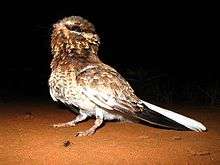White-winged nightjar
| White-winged nightjar | |
|---|---|
 | |
| Scientific classification | |
| Kingdom: | Animalia |
| Phylum: | Chordata |
| Class: | Aves |
| Order: | Caprimulgiformes |
| Family: | Caprimulgidae |
| Genus: | Eleothreptus |
| Species: | E. candicans |
| Binomial name | |
| Eleothreptus candicans (Pelzeln, 1867) | |
| Synonyms | |
|
Stenopsis candicans Pelzeln, 1867 | |
The white-winged nightjar (Eleothreptus candicans) is a species of nightjar in the Caprimulgidae family native to Bolivia, Brazil and Paraguay where it lives in open grassland with scattered trees. It is about 20 cm (8 in) long, with females being slightly larger than males. It is usually a silent bird, but the male calls during courtship. It breeds in the summer, with the female incubating the eggs and rearing the young. It has a wide range but the population is declining, probably because of a decrease of suitable habitat, so the International Union for Conservation of Nature has assessed its conservation status as being "endangered".
Behaviour
This species is known to be silent except when the male is putting on displays for a female. The displays usually happen in the moonlight by anthills, and the male spreads his wings out. It is a nocturnal bird. It flies at night in order to prey for food. The first white-winged nightjar nest that was discovered in the year of 1997. In the country of Paraguay, it is recorded that nesting occurs between the months of September and December. The female takes on all the duties of incubating and watching over the nest.[2]
Taxonomy
The taxonomy of the white-winged nightjar is as follows:
- Kingdom-Animalia
- Phylum-Chordata
- Class-Aves
- Order-Caprimulgiformes
- Family-Caprimulgidae
- Genus-Eleothreptus[2]
Size
The average length of the white-winged nightjar is about 19–21 cm. The average weight of a male is from 46-55 grams. The average female weight is about 51-56 grams.[2]
Distribution
It is found in Bolivia, Brazil, and Paraguay.[3] Its natural habitat is subtropical or tropical dry lowland grassland. The white-winged nightjar is native to open grasslands that have scattered trees and bushes, shrubs or dwarf palms, and anthills and termite mounds.[2]
Biology
It is threatened by habitat loss. The species is widely distributed, but within the range of the species, there are several factors that are lowering and threatening the population size. The expansion of agriculture creates a threat to their habitat. There are also man-made fires that clear out the vegetation that affect the habitat as well. The invasion of grasses that are not native to the area also pose as a threat to the white-winged nightjar.[2] The International Union for Conservation of Nature has assessed its conservation status as being "endangered".[1]
References
- 1 2 BirdLife International (2012). "Eleothreptus candicans". IUCN Red List of Threatened Species. Version 2013.2. International Union for Conservation of Nature. Retrieved 26 November 2013.
- 1 2 3 4 5 "White-winged nightjar (Eleothreptus candicans)". Arkive. Retrieved 27 January 2013.
- ↑ "Eleothreptus candicans". International Union for Conservation of Nature and Natural Resources. Retrieved 27 January 2013.
